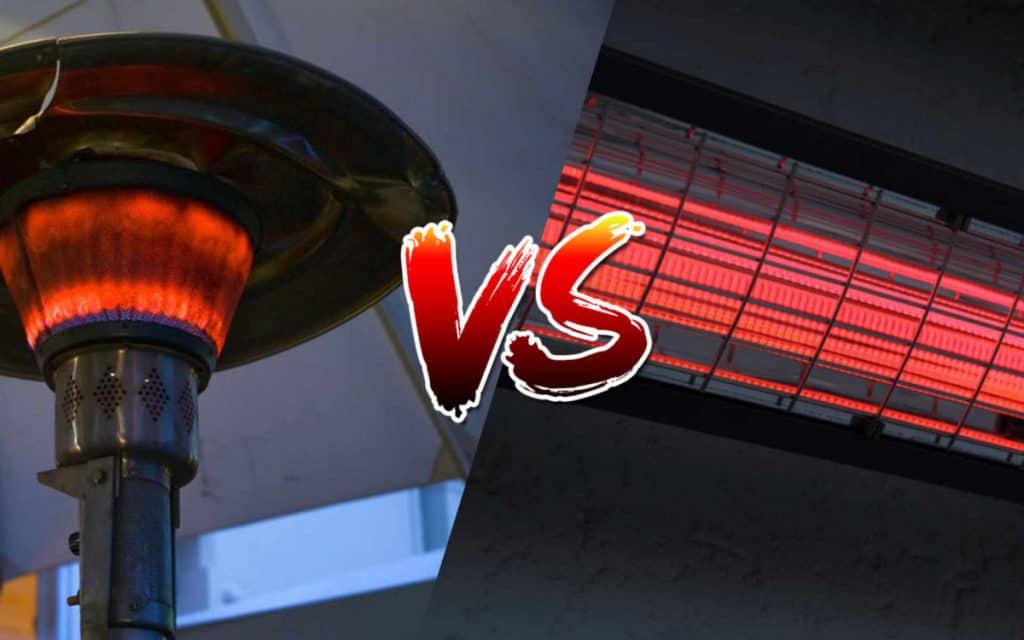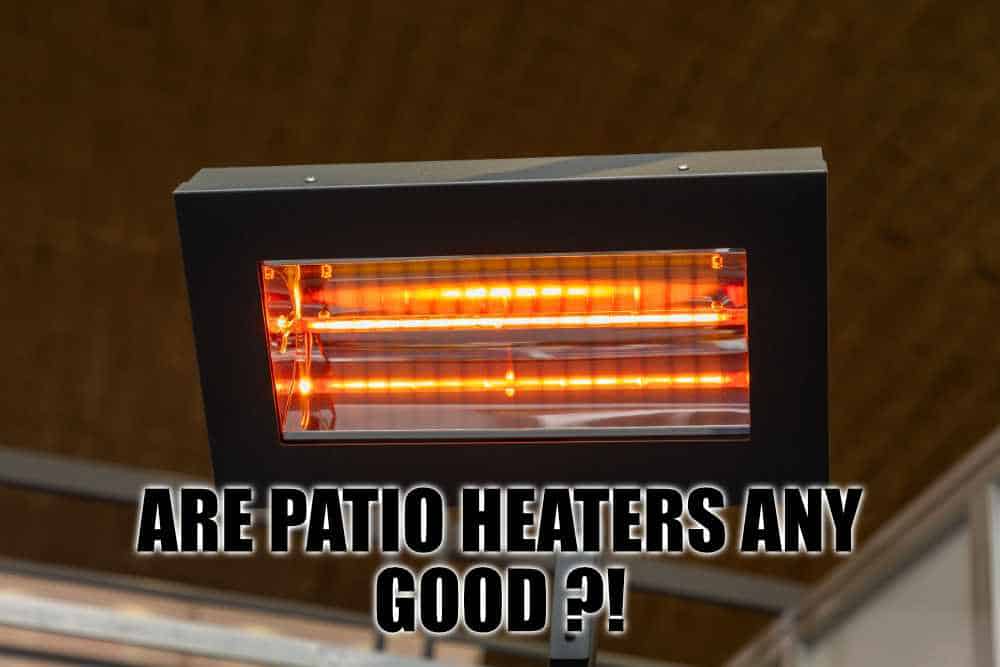There’s a good amount of warranted skepticism surrounding outdoor heaters, but not all of them are equally horrific for the environment. Infrared patio heaters.
For example, are extremely efficient and eco-friendly, making them the leading technology on the market.
If the words “eco-friendly” and “patio heater” don’t seem like they belong in the same sentence, we’re more than happy to dispel that notion in the next couple of paragraphs.
Down below, you’ll learn what makes infrared outdoors heating as compelling as it is. We’ll also go into a bit of detail on how they work and why they’re so efficient.
If the physics of heating isn’t your forte, don’t worry: we’re keeping all of the info simple and beginner-friendly.
What Makes Infrared Patio Heaters Any Better Than Other Outdoor Heater Technologies?

The main reason to use infrared heating lies in its efficiency. Infrared patio heaters are safer, cheaper, and more ecologically acceptable than virtually any other outdoors heating technology we currently have access to. It’s that simple.
Using an infrared heater is the optimal solution for most outdoor situations, and though gas does have some upsides over infrared, they’re spread pretty thinly compared to infrared.
The only way for you to get more mileage out of gas heating is if you already have it available and ready to go. Even then, gas is expensive already and likely to become even more expensive in the future.
If you’re looking to get a new outdoor heating system for your patio, infrared is ultimately the best option to consider by far.
How Does Infrared Heating Work?
Much like the Sun itself, infrared warms things up by oscillating molecules, which in turn then release heat and generate warmth.
This effect is accomplished by the generation of electromagnetic radiation in the infrared spectrum. Perfectly safe, mind.
What this means is that infrared patio heaters don’t actually warm up the air around you at all.
Instead, they warm you up directly, delivering the same feeling of warmth as the big yellow ball in the sky does.
What Makes Infrared Heating More Eco-Friendly Than, Say, Gas?
One of the best things about using an infrared patio heater is that it’s not at all reliant on burning up fossil fuels.
It’s the 21st century, after all, and the less carbon we collectively pump into the atmosphere, the better.
On average, electric patio heaters have only about 15% of the total CO2 footprint of comparable gas heaters, according to the UK’s Department for Environment, Food, and Rural Affairs (DEFRA).
That’s a massive difference between the two heating technologies.
Keep in mind that gas heaters are also horribly inefficient compared to infrared, with up to 70% of their energy expenditure usually getting wasted. Infrared heats up things and people, while gas heats up the surrounding air.
Worse yet, gas also gives off fumes, to the point where the technology is getting outright banned in some places, like in France.
Relying on infrared panels for outdoors heating is one of those small things that come together to make a big difference in the end, so why bother with gas?
Is Using an Infrared Patio Heater Energy-Efficient?
There’s no point in beating around the bush: heating up space with an infrared heater can be up to ten times more cost-effective than doing so with a fossil fuel system.
We had already touched upon why this is the case, as it has to do with the physics of how different heaters work.
While burning gas or oil warms up the air surrounding the heater, infrared electromagnetic radiation wastes no energy doing this.
While gas-heated air will slowly but surely dissipate and escape the outdoor space you’re trying to keep warm, infrared heaters will keep things toasty for as long as they’re running with minimal changes in the micro-climate.
Is Safety a Concern With Infrared Heating?
Not in any appreciable way, no. Outdoor heaters of this kind are perfectly safe, as they deliver warmth in the infrared spectrum tuned between 9 and 14 microns.
This is commonly referred to as “far infrared”, since the generated EM radiation can travel across significant distances before dissipating.
Naturally, most infrared patio heaters will have the heat-generating panels protected in some way.
This is because the panels themselves can (and will) reach very high temperatures, up to 90 degrees Celsius. For our American friends, that’s a whopping 194 degrees Fahrenheit.
Really high-powered infrared heating solutions will often have height installation requirements, so as to make it impossible for most people to accidentally come into contact with the panels.
Smaller, floor-mounted heaters are usually not quite that powerful. They are often sold with pre-installed shielding systems, such as a simple metal cage.
The important takeaway here is that infrared is safe, long as you remember not to touch the hot bits.
Are There Any Upsides to Using Gas Over Infrared?
Generally speaking, gas heaters do output a bit more heat than infrared heaters do, and since they warm up the air, this kind of heat transfer has a lingering effect.
How long it lingers will, naturally, depend entirely on the local weather conditions you are facing.
Gas heaters also might end up being a lower upfront expense for commercial users who need to warm up a substantially large area at once.
The thing to keep in mind here, though, is that the savings are a diminishing return when you account for the cost of gas itself.
Since a single gas heater will burn up about 1-1,5 kilogram of gas every hour, the pricing is highly variable.
It’s very unlikely that installing gas outdoor heaters will be more cost-effective in the long run, and there’s the environmental effect to consider as well.
Benefits of Using Infrared Patio Heaters
You’ve probably managed to glean a variety of infrared heating benefits from the article already. That said, we do have a few more things for you to consider.
Minimum Maintenance, Maximum Weather-Proofing
Infrared heating requires no moving parts: the panels merely warm up when you turn them on, and cool down when you turn them off. That’s really all there is to it.
Daily driving an infrared heater will, then, virtually never lead to maintenance requirements. There’s nothing to lube up, nor is there anything mechanical that could actually break down.
This comes in particularly handy when the weather picks up. Whether it’s snowing or raining, a heater of this type will keep trucking.
No wind can affect electromagnetic radiation, after all, and if you’re in an area with lots of precipitation, infrared is your best bet.
Easy Installation
Ease-of-use is an all-important feature of every piece of modern technology, and heating is no different.
Infrared heaters are often exceedingly compact and can be installed in a wide variety of configurations, depending on your specific needs.
For example, you could always just put down a tower heater if there’s no other option for installation.
If, on the other hand, you want to keep your space clean and clear, you might opt for a wall or ceiling-mounted solution.
With infrared heaters, everything goes. Since they only require a single cable’s worth of infrastructure foresight, any comparison with gas or oil heaters flies right out the window.
Remember: both gas and oil need to be stored somewhere for you to burn them up.
Clean and Silent
Quality of life is crucial when it comes to any long-term investment. Predictably, this is another aspect in which no other heating technology can compare with infrared.
What you’re getting here is a silent, clean, and completely smell-free heating solution. The infrared panel won’t emit anything other than heat, and it won’t get in your way in any shape or form.
Infrared patio heaters are an elegant solution in just about every way that matters.
More Cost-Effective than Fossil Fuels

On average, infrared patio heaters cost about 15% of the total cost of running gas patio heaters. That comes on top of the other fossil fuel burning information we mentioned before.
Of course, the exact cost of operating any outdoor heater will vary a great deal depending on where you live.
Before installing one, make sure to reference your local electricity provider, then compare and contrast with your potential fossil fuel heating expenditures.
Check twice, spend once. Chances are that you’ll like what you see, far as infrared heating goes.
Infrared Patio Heaters Are a Good Choice
With an infrared patio heater, you’re getting the full package, as we’ve shown above.
The technology is clean, efficient, and silent. It doesn’t smell, nor does it expose the users to potential dangers.
On top of all that, infrared doesn’t emit noxious fumes into the atmosphere, and when it comes to the day-to-day operation, it costs a fraction of the price of other comparable heating systems.
Further still, setting up infrared heating is as simple as putting the heater down and plugging it in. A far cry from, say, all the headaches that gas installation can lead to.
Infrared patio heaters are a stellar choice for any situation, and chances are that they’re right for you, too.
Alright guys, that’s it for this article, if you are interesting in reading more about patio heaters, we have lots of cool articles related such as:
Can Patio Heaters be Used on a Deck (Read This First!)
Can Patio Heaters be Used on a Screened-in Porch? (Quick Facts)
Do Patio Heaters Use A Lot of Electricity? (3-minute Read)
Can Patio Heaters Explode? (Important Facts)
Why do Patio Heaters Stop Working (Common & Uncommon Faults)
References
Case Studies of Market Transformation: https://sustainabledevelopment.un.org/content/documents/full_rpt.pdf

